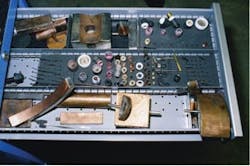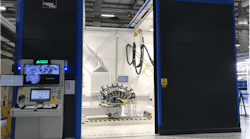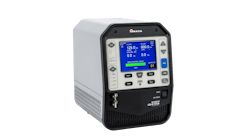Delta Air Lines Technical Operations Center in Atlanta (Delta TechOps; 866-MRO-Delta or [email protected]) is the largest airline MRO in North America. In addition to providing maintenance and engineering support for Delta’s fleet of aircraft, Delta TechOps serves more than 100 aviation and airline customers from around the world, specializing in high-skill work like engines, components, base and line maintenance.
Delta TechOps considers much of its work sheet metal. Metal thicknesses average 0.030 inch, with 0.012 inch being considered extremely thin and 0.063 inch considered “thick” sheet metal. Applications include:
- All of the ducting. Ducting is made from Inconel 625, Titanium (commercially pure and Ti-6Al-4V grades), and 6061-T6 aluminum.
- “Hot section” parts (combustion area) made from nickel and cobalt alloys.
- The APU (auxiliary power unit) which uses several different grades of stainless steel.
For best results when welding sheet metal in aircraft applications, consider the following advice from Jody Collier, a senior certified welding inspector (SCWI) and instructor/developer, welding training/certification with Delta TechOps.
Rule of thumb: 1 for 1
To estimate required heat input, a good rule of thumb is to use 1 amp per 1 thousandth (0.001) inch of thickness for carbon steel. Stainless steel and other nickel-based metals require slightly less heat — perhaps just 2/3 of an amp per thousandth — because nickel conducts heat poorly. For aluminum and magnesium (excellent heat conductors), increase heat input slightly.
Chill out
Use copper chill bars with argon (shielding gas) ports. Both the copper and the gas draw heat away from the weld area. Delta TechOps fabricates its own chill bars in a wide variety of shapes and sizes. It’s OK to use a copper shoe attached to a steel s tructure, but configure the bar so that the copper touches the weldment.
Caution: Do not put copper in direct contact with cobalt alloys, as any zinc in the copper may cause issues in high-temperature applications. In these instances, nickel-plate the chill bars.
Cover your backside
When it comes to welding sheet metal, Delta TechOps treats most applications (except aluminum) as it would titanium. Titanium always requires shielding the backside of the weld to prevent oxidation (“sugaring”). In thin applications, shielding gas on the backside of the weld reduces heat input. It also improves weld quality by eliminating metal surface imperfections (the irregularity of sugaring) that could be a potential source of cracking in high-fatigue applications.
Love the back-step
The standard practice when TIG welding involves pushing the weld puddle in one continuous direction for the entire length of the weld. With back-stepping, the welder breaks up the seam in sections to dissipate the heat. Welders start at position 1 and weld out to the right edge. They then move to position 2 and weld toward position 1, tying-in with the first weld. The length of each step varies by application; thicker material and better part restraint (fixturing) may permit a longer weld. At Delta TechOps, the average step is about 1-inch long and never longer than 2 inches. Do not confuse the back-step method — a planned series of steps along a single joint — with the randomness of skip welding.
Supersize me
Other sheet metal applications (e.g., stainless steel in food service) typically call for a size #7 TIG cup. For welding sheet metal in aerospace applications, use a #15 cup (15/16-inch diameter) or larger. A large cup provides better gas coverage of the weld puddle and heat affected zone, thus reducing total heat input and improving bead quality. It should also improve bead appearance and reduce the need for post-weld wire brushing to remove oxidation.
Lens crafter
Always use a TIG torch with a gas lens. The lens, a screen inserted inside the cup, smoothes gas flow and prevents turbulence, which in turn widens the area of gas coverage. If necessary, it allows increasing electrode extension from 1/4- to 3/4-inch beyond the cup. Extending the electrode permits reaching into corners and better visibility of the weld area.
Mind the gap
To perform maintenance on some parts, Delta TechOps must cut them apart to gain access and then re-weld the part … while maintaining the part’s original dimensions. All parts shrink when welded, so plan ahead. Good R&D work, good fixturing, and experience can provide an indication of how much to “pre-gap” a part prior to welding. In other instances, if possible, create parts that are slightly larger than required and cut off or machine away excess material after welding.
To the point
Electricity likes to come off a point. Nothing focuses an arc more than a needle-sharp tungsten. A sharp tungsten directs the heat where you want it (and away from areas you don’t). Also, don’t weld with contaminated tungsten; it’s a recipe for rework.
Note that Delta TechOps has standardized on lanthenated electrodes for all applications. It holds a sharp point for low-amperage welding, works well with AC TIG on aluminum and magnesium, and works well for high-speed pulsed DC TIG.
Invert your thinking
High-speed pulsed DC TIG welding (100 to 150 pulses per second (PPS) or greater), stiffens and narrows the arc cone, greatly increasing a welder’s directional control over the weld puddle. Further, high-speed pulsing reduces total heat input. With conventional TIG technology and welding near an edge, welders have to stay on their toes to prevent the weld puddle from wicking over and melting the edge; there’s simply no extra metal to conduct the heat.
Note that conventional TIG welders cannot pulse faster than 10 PPS, where welders such as Miller Electric Mfg. Co.’s Maxstar and Dynasty inverters permit high-speed pulsing (500 or 5,000 PPS, depending on the model). As budget permits, Delta TechOps is adding more TIG inverters to its fleet for pulsed welding in many DC TIG applications. Collier concludes that, “Any tool that gives you more control over heat input is a good tool, especially in the high-precision world of aircraft maintenance.”
Brush up
Keep separate brushes for different metals to prevent cross contamination. Write the metal type on the handle of every brush. Stainless steel won’t be stainless and aluminum won’t be nonferrous if you clean the weld with a brush impregnated with carbon steel particles.


